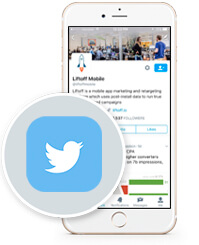Q&A with Nick
Nick Quan was formerly Senior Performance Marketing Manager at Twitter, focused on acquiring new users through paid mobile channels. He was previously at EA, where he managed the mobile user acquisition efforts for mobile titles like Madden, FIFA, and Iron Force.
Read Nick's latest article: "Mobile Marketing Musings with Nick Quan"
What drove you to get started in mobile marketing?
I was lucky enough to fall into mobile marketing when it started to take off within the world of app marketing in 2011. Once I saw how quickly the industry was evolving around me, I was hooked. Being able to work with a great community of people in an industry where everyone was learning together was exciting and impactful.
What do you like most about mobile marketing?
The ad tech and metrics driven decision making are what I like the most about mobile marketing. Performance marketing is the engine that allowed mobile marketing to grow into what it is today. Ad partners meet this demand with ad tech built to optimize goals like CPI and post install events at scale.
What does it take to succeed in mobile marketing?
Identifying performance indicators and working closely with your ad partner to pass these events to them is key and, of course, working with the right ad partners with the right ad tech. Having strong analytics and attribution are also needed to create LTV models that give you the ability to accurately track against return on ad spend (ROAS) and help you make more informed optimization decisions based on attributed data.
Using data to dictate where your ad spend should be invested and to make iterations on your creative to increase eCPMs are both very important when you are competing against advertisers for the same ad impression. Lastly, but not least, understanding your audience will allow you to make better decisions when thinking about new ad formats and/or publishers to test while keeping the user experience in mind.
What does a quality mobile user look like to you?
User retention, engagement, and generated revenue are the attributes of a quality mobile user to me -- which are all the factors that go into LTV. Assuming you have return on ad spend goals, you'll want to know what you should be paying to acquire users which can be done by deriving a LTV at the most granular level possible. Ideally, you would have LTV by country, OS, and ad partner, to inform CPA targets on each of these levels.
What strategies work best to convert installs into engaged users?
I would first educate myself on what an engaged user looks like when they interact with the product you are marketing. Once you know the steps a user takes that leads to an engaged user, help new users get there with a sequenced lifecycle marketing campaign consisting of push notifications, email, and off platform paid re-engagement campaigns.
At some point, the product will need to take over and retain users, but during those first crucial days, where you lose the most users, you can use marketing to turn installs into engaged users. When launching a new app, I've found that working closely with the product team during soft launches is a strong strategy to help improve the new user onboarding experience before the world wide release.
What have you done in the past year to help better monetize your app?
As a performance marketer, I am always looking to scale high LTV paid users which you can do through a variety of ways. The most common methods are blacklisting sites that are delivering low LTV users, passing back high LTV events back to your ad partner's algorithms as an additional event to optimize against, and optimizing creative to increase your eCPMs on sites that you know are performing well for you. These methods will help ensure your money is spent acquiring engaged users.
What is the biggest challenge in marketing your apps?
The lack of transparency and impression data are frustrating in the industry today. It surprises me that all ad partners are not able to report on impression data, this will need to change if marketers want accurate multi-touch attribution reporting. Transparency also needs to happen. Marketers need to know where they are placing their ads, for brand safety and ad relevance. We should all be keeping the user's experience in mind, which is much harder to do when marketers do not know the publisher the user is on when interacting with our ads.
How do you stay ahead of changes in technology?
Staying on top of what's happening in the industry on a regular basis has helped me identify trends on what could be coming next. However, you're only as good as the people you surround yourself with. Your ad vendors and internal analytics team are key partners to deliver UA results, so working closely with these teams on upcoming trends is a great way to stay ahead of changes in technology.
What do you see is the next big thing in mobile marketing?
I see transparency and multi-touch attribution analytics tying desktop and mobile campaigns together as big things coming up in mobile marketing. If you look at the evolution of desktop advertising timeline and compare this to mobile advertising, I believe they will look similar as time progresses.
Do you plan to run re-engagement campaigns in the next 12 months? If so, what does that flow look like for your app?
Yes, with multiple flows tailored to the audience we are re-engaging for an optimal user experience. We have tons of user interest data and a unique product that can deliver on nearly any interest a user may have. As I mentioned earlier, I believe re-engagement should be a sequenced campaign consisting of push, email, and off platform marketing with an end goal of getting the user content they are interested in. You don't necessarily need to use all three of these campaigns and should use the methods users engage most with.
























